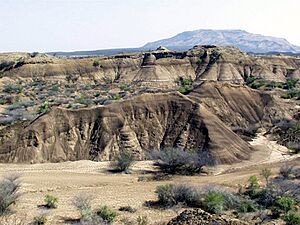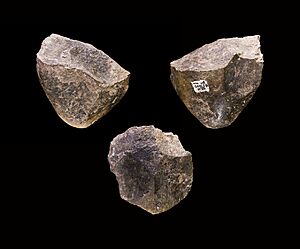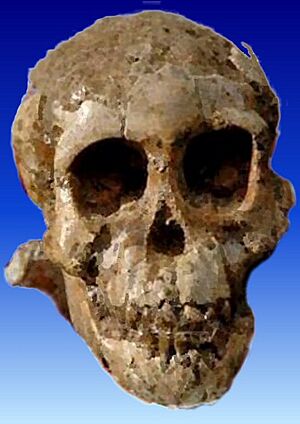Prehistoric Ethiopia facts for kids
Ethiopia is a very special place! Scientists believe that the first modern humans came from this area. Amazing discoveries have been made there, showing us how early humans developed over millions of years.
For example, fossils of early human ancestors like Australopithecus afarensis (nicknamed "Lucy") who lived 3.2 million years ago, and Ardipithecus ramidus (nicknamed "Ardi") who lived 4.4 million years ago, have been found. People started settling in what is now Ethiopia during the Late Stone Age. Farming, which changed how people lived, began around 3,000 BCE.
Different groups of people, speaking Afroasiatic languages (like Semitic, Cushitic, and Omotic) and Nilo-Saharan, began to form their own unique cultures and languages around 2,000–1,000 BCE.
Contents
Discovering Early Human History
Scientists have found many important clues about early humans in Ethiopia. These discoveries help us understand our past.
Ancient Tools at Melka Kunture
One of the first big digs in Ethiopia was at a Stone Age site called Melka Kunture. In 1963, Gerard Dekker found layers of rock there that showed fossils from 1.7 million years ago. Later, from 1965 to 1995, a French scientist named Jean Chavallion explored the site even more. They found fossils of Homo erectus (an early human species) that were 1.5 to 1.7 million years old. They also found pieces of skulls from early Homo sapiens, which are like us!
Omo Remains: Very Old Human Bones
Between 1967 and 1974, scientists found human bones in the Omo Kibish area. These bones, called the Omo remains, are about 200,000 years old. This makes them some of the oldest Homo sapiens fossils ever found.
Lucy: A Famous Ancestor
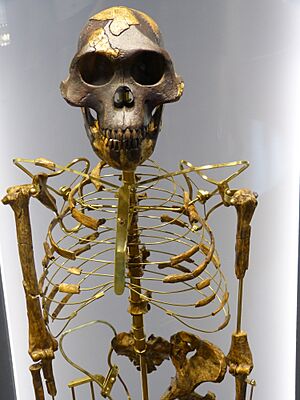
In 1974, an American scientist named Donald Johanson made a huge discovery. He found a 3.2-million-year-old fossil of an early female human ancestor in Hadar. She was an Australopithecus afarensis and was nicknamed "Lucy". In Ethiopia, she is called "Dinqnesh". Lucy was about 3.5 feet tall and weighed around 60 pounds.
Ardi: Even Older Clues
Between 1992 and 1994, a team led by Tim D. White found an even older fossil. This was the first Ardipithecus ramidus fossil, nicknamed "Ardi". It was found in the Middle Awash area and is 4.4 million years old! Scientists later found over 100 more pieces of Ardi. These early human ancestors probably ate plants, meat, and fruit. Scientists announced their amazing findings about Ardi in 2009. Ardi had some human-like features, such as smaller teeth and signs that she might have walked upright.
Selam: The Ancient Baby
In 2000, scientists led by Zeresenay Alemseged found a 3.3-million-year-old baby Australopithecus afarensis fossil. They nicknamed her "Selam". The search for more clues continued! In 2001, Yohannes Haile-Selassie found fossils of a 5.2-million-year-old Ardipithecus ramidus family. He has also found other human ancestor fossils in the Afar Region.
How People Settled and Lived
People have been living in Ethiopia for a very long time, and their ways of life changed over thousands of years.
The Start of Farming
During the Late Stone Age, around 9,000 BCE, people in Ethiopia made small stone tools. It's not clear if these early people started raising animals right away. However, ancient rock paintings in the Hararghe region and Eritrea show that people began to tame animals like cattle and make pottery. They also made tools like hand axes, hoes, and grinding stones. This suggests that by the late 3rd millennium BCE, simple farming had started in many parts of western Ethiopia.
Evidence of stone tools and drawings has also been found in limestone caves near Dire Dawa. Some findings suggest that tool-making skills came to Ethiopia from Sudan through the Blue Nile Valley.
Early Ethiopians began growing grains during the Chalcolithic Age (6,200–3,000 BCE). The invention of the plow for farming likely meant that cattle were tamed around the same time. By the Early Bronze Age (3,000 BCE), animals like cattle, sheep, goats, and donkeys were being raised by people.
Spreading Languages and Cultures
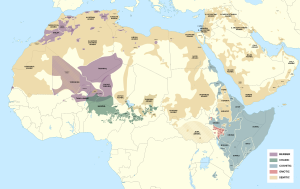
Scientists who study languages believe that early Ethiopians spoke Afroasiatic languages around 3,000 BCE. These languages might have come from the eastern Sahara desert after it became dry. In the 1950s, experts thought that Afroasiatic was the ancestor of five main language groups: Ancient Egyptian, Berber, Semitic, and Cushitic. Later, Harold Fleming suggested adding a sixth group, Omotic. He thought the Afroasiatic languages might have started in southwestern Ethiopia.
The groups that spoke proto-Cushitic and proto-Omotic languages began to separate around 4,000 or 5,000 BCE. The proto-Semitic language group moved towards Asia Minor. Some research suggests that the Afroasiatic language family started spreading around 13,000 BCE. Independent language studies show that Semitic speakers were present in Ethiopia by at least 2,000 BCE. During this time, the early Ethiopian people split into five main groups:
- Northern Cushites: These people were known as "Blemmyes" or "Beja" by the ancient Greeks. They spoke a dialect called "Bedawie". They were nomads, meaning they moved around with their animals in the desert lowlands near the Red Sea in northern Ethiopia and Eritrea.
- Central Cushites: They spoke the "Agaw" dialect and lived in northwestern Ethiopia. They were known for using plows to grow grains.
- Eastern Cushites: These groups lived southwest of the Great Rift Valley. Their East Cushitic language was divided into many different tribal dialects. They grew grains and root vegetables using hoes. They also used advanced terraced farming methods.
- Semitic Speakers of Ethiopia: The exact origin of this group is not fully clear. By the 1st millennium BCE, they had split into two main branches: one in the northern plateau region and another in the central part of the country. This group includes seven different ethnic clusters with unique customs and ways of life.
- Omotic Speakers in Southwest Ethiopia: These people grew grains and root vegetables using hoes. They were known for their special system of ritual monarchy. The Omotic society was very diverse, with about fifty subgroups, each having its own language and culture.
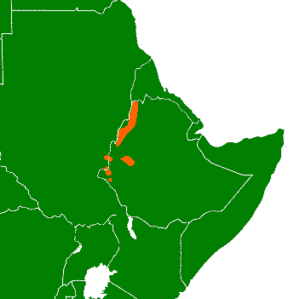
The Nilotic peoples from Sudan also moved into the greater Ethiopia area in different stages. The first Nilotic groups arrived around 3,000 BCE. They were mostly farmers who grew sorghum and root plants like enset and yams. Today, their descendants include the Berta, Gumuz, and Koma people in western Ethiopia.
The second wave of Nilotic migration happened in the 1st millennium BCE. These groups were known for raising cattle and growing millet. They settled in the western edge of Ethiopia. These Nilotic groups include two tribes: the Anyuak and the Nuer.


